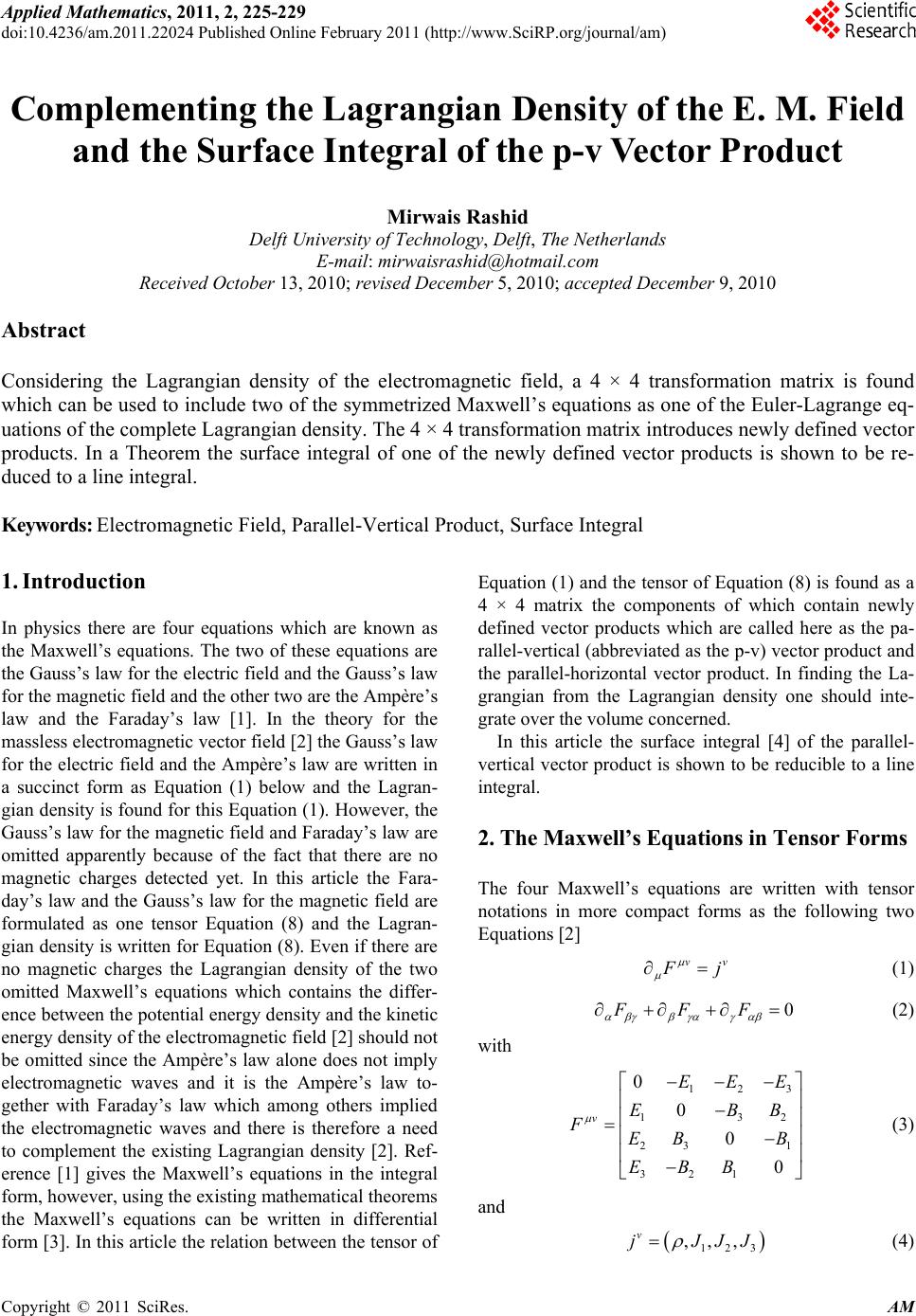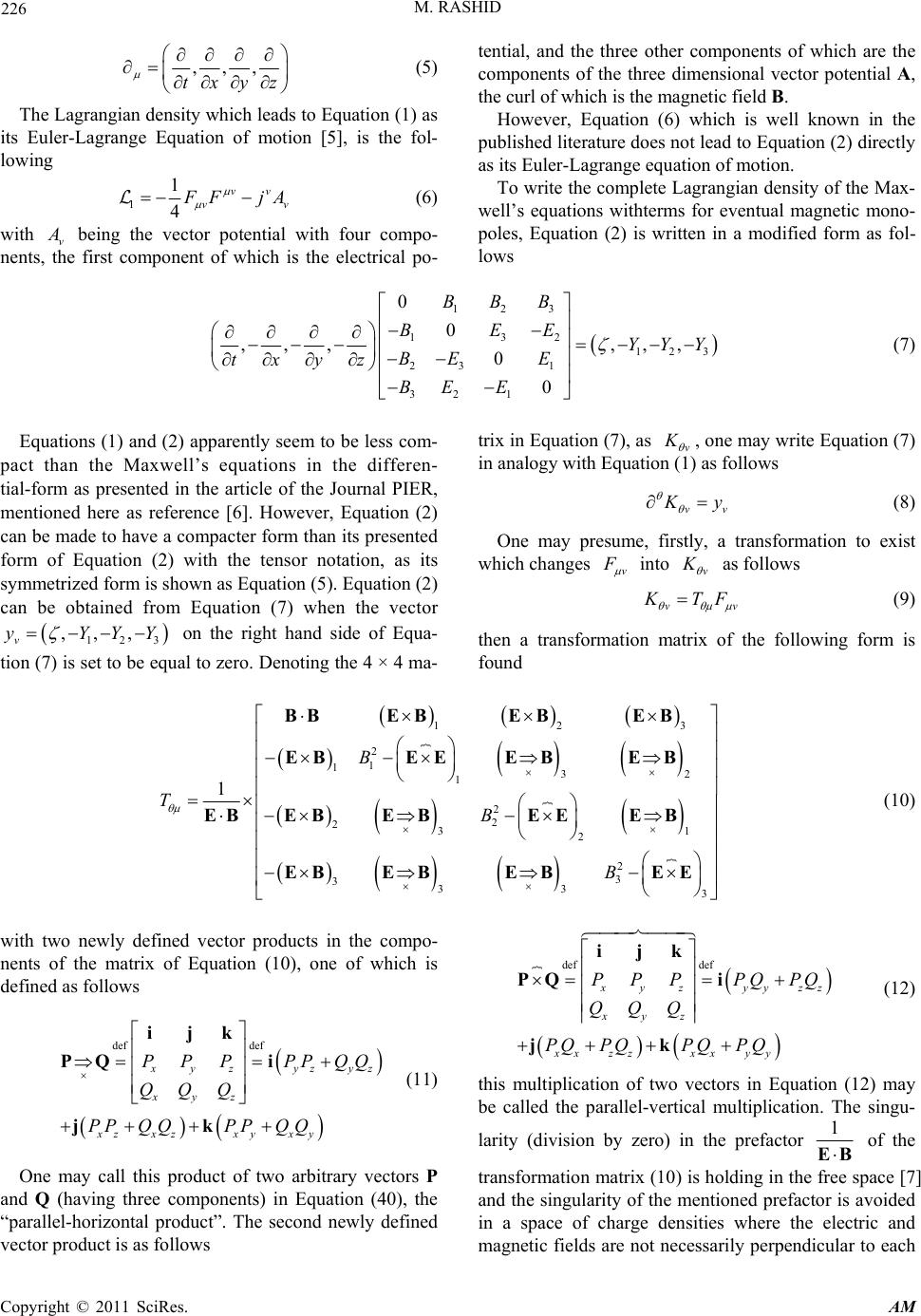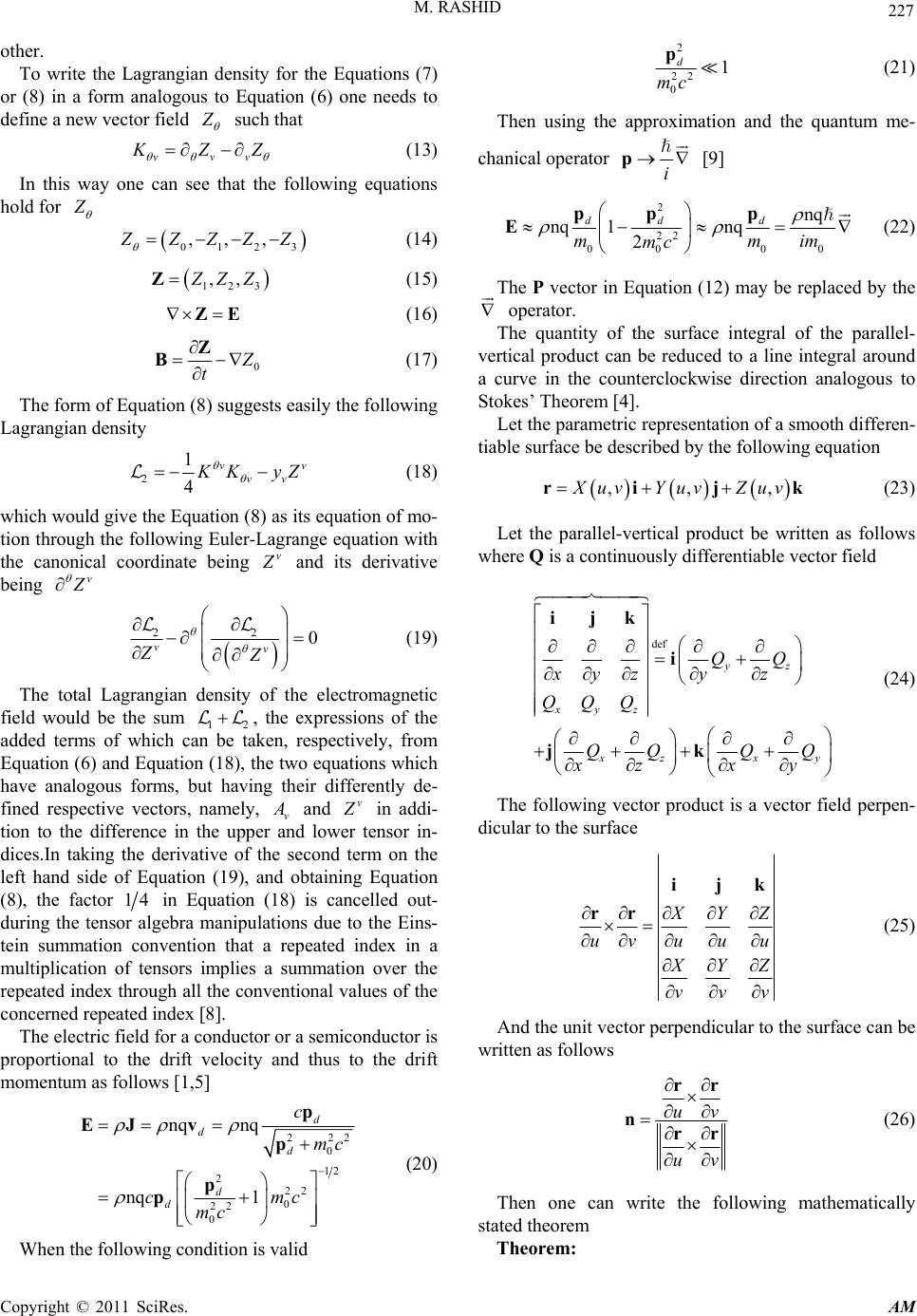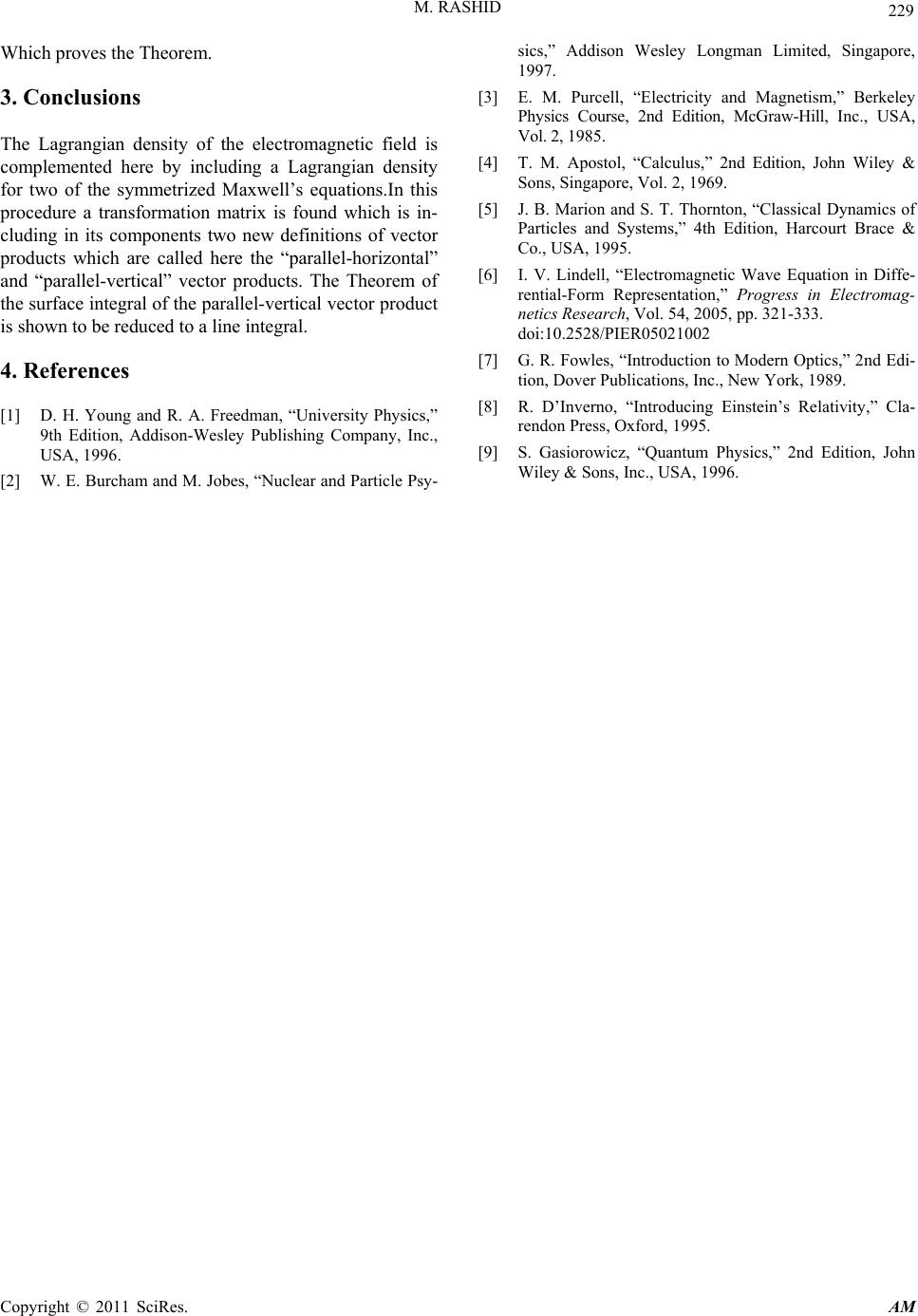Paper Menu >>
Journal Menu >>
 Applied Mathematics, 2011, 2, 225-229 doi:10.4236/am.2011.22024 Published Online February 2011 (http://www.SciRP.org/journal/am) Copyright © 2011 SciRes. AM Complementing t he La gr angian Density o f t he E . M . Fi eld and the Surface Integral of the p-v Vector Produc t Mirwais Rashid Delft University of Technology, Delft, The Netherlands E-mail: mirwaisrashid@hotmail.com Received October 13, 2010; revised December 5, 2010; accepted December 9, 2010 Abstract Considering the Lagrangian density of the electromagnetic field, a 4 × 4 transformation matrix is found which can be used to include two of the symmetrized Maxwell’s equations as one of the Euler-Lagrange eq- uations of the complete Lagrangian density. The 4 × 4 transformation matrix introduces newly defined vector products. In a Theorem the surface integral of one of the newly defined vector products is shown to be re- duced to a line integral. Keywords: Electromagnetic Field, Parallel-Vertical Product, Surface Integral 1. Introduction In physics there are four equations which are known as the Maxwell’s equations. The two of these equations are the Gauss’s law for the electric field and the Gauss’s law for the magnetic field and the other two are the Ampère’s law and the Faraday’s law [1]. In the theory for the massless electromagnetic vector field [2] the Gauss’s law for the electric field and the Ampère’s law are written in a succinct form as Equation (1) below and the Lagran- gian density is found for this Equation (1). However, the Gauss’s law for the magnetic field and Faraday’s law are omitted apparently because of the fact that there are no magnetic charges detected yet. In this article the Fara- day’s law and the Gauss’s law for the magnetic field are formulated as one tensor Equation (8) and the Lagran- gian density is written for Equatio n (8). Even if there are no magnetic charges the Lagrangian density of the two omitted Maxwell’s equations which contains the differ- ence between the potential energy density and the kinetic energy density of the electromagnetic field [2] should not be omitted since the Ampère’s law alone does not imply electromagnetic waves and it is the Ampère’s law to- gether with Faraday’s law which among others implied the electromagnetic waves and there is therefore a need to complement the existing Lagrangian density [2]. Ref- erence [1] gives the Maxwell’s equations in the integral form, however, using the existing mathematical theorems the Maxwell’s equations can be written in differential form [3]. In this article the relation between the tensor of Equation (1) an d the tensor of Equation (8) is found as a 4 × 4 matrix the components of which contain newly defined vector products which are called here as the pa- rallel-vertical (abbreviated as the p-v) vector product and the parallel-horizontal vector product. In finding the La- grangian from the Lagrangian density one should inte- grate over the vol ume concerned. In this article the surface integral [4] of the parallel- vertical vector product is shown to be reducible to a line integral. 2. The Maxwell’s Equations in Tensor Forms The four Maxwell’s equations are written with tensor notations in more compact forms as the following two Equations [2] vv F j (1) 0FFF (2) with 123 132 23 1 321 0 0 0 0 v EEE EBB FEB B EBB (3) and 123 ,,, v jJJJ (4)  M. RASHID Copyright © 2011 SciRes. AM 226 ,,, txyz (5) The Lagrangian density which leads to Equation (1) as its Euler-Lagrange Equation of motion [5], is the fol- lowing 11 4 vv vv F FjA (6) with v A being the vector potential with four compo- nents, the first component of which is the electrical po- tential, and the three other components of which are the components of the three dimensional vector potential A, the curl of which is the magnetic field B. However, Equation (6) which is well known in the published literature does not lead to Equation (2) d irectly as its Euler-Lagrange equation of motion. To write the complete Lagran gian density of the Max- well’s equations withterms for eventual magnetic mono- poles, Equation (2) is written in a modified form as fol- lows 123 132 123 231 32 1 0 0 ,,, ,,, 0 0 BBB BEE YYY BEE txyz BE E (7) Equations (1) and (2) apparently seem to be less com- pact than the Maxwell’s equations in the differen- tial-form as presented in the article of the Journal PIER, mentioned here as reference [6]. However, Equation (2) can be made to have a compacter form than its presented form of Equation (2) with the tensor notation, as its symmetrized form is shown as Equation (5). Equation (2) can be obtained from Equation (7) when the vector 123 ,,, v y YYY on the right hand side of Equa- tion (7) is set to be equal to zero. Denoting the 4 × 4 ma- trix in Equation (7), as v K , one may write Equation (7) in analogy with Equation (1) as follo ws vv K y (8) One may presume, firstly, a transformation to exist which changes v F into v K as follows vv K TF (9) then a transformation matrix of the following form is found 123 2 1 132 1 2 2 231 2 2 3 333 3 1 B TB B BB EBEBEB EBEEE BE B EB EBEEEB EB EBE BE BEE (10) with two newly defined vector products in the compo- nents of the matrix of Equation (10), one of which is defined as follows def def x yz yzyz xyz xzx zxyxy PPP PPQQ QQQ PP QQPPQQ ijk PQ i jk (11) One may call this product of two arbitrary vectors P and Q (having three components) in Equation (40), the “parallel-horizontal product”. The second newly defined vector product is as follows def def x yz yyzz xyz xx zzxxyy P PP PQPQ QQQ PQ PQPQ PQ ijk PQ i jk (12) this multiplication of two vectors in Equation (12) may be called the parallel-vertical multiplication. The singu- larity (division by zero) in the prefactor 1 EB of the transformation matrix (10) is holding in the free space [7] and the singularity of th e mentioned prefactor is avoided in a space of charge densities where the electric and magnetic fields are not necessarily perpendicular to each  M. RASHID Copyright © 2011 SciRes. AM 227 other. To write the Lagrangian density for the Equations (7) or (8) in a form analogous to Equation (6) one needs to define a new vector field Z such that vvv K ZZ (13) In this way one can see that the following equations hold for Z 0123 ,,, Z ZZZZ (14) 123 ,, Z ZZZ (15) ZE (16) 0 Z t Z B (17) The form of Equation (8) suggests easily the following Lagrangian density 21 4 vv vv K KyZ (18) which would give the Equation (8) as its equation of mo- tion through the following Euler-Lagrange equation with the canonical coordinate being v Z and its derivative being v Z 22 0 vv ZZ (19) The total Lagrangian density of the electromagnetic field would be the sum 12 , the expressions of the added terms of which can be taken, respectively, from Equation (6) and Equation (18), the two equations which have analogous forms, but having their differently de- fined respective vectors, namely, v A and v Z in addi- tion to the difference in the upper and lower tensor in- dices.In taking the derivative of the second term on the left hand side of Equation (19), and obtaining Equation (8), the factor 14 in Equation (18) is cancelled out- during the tensor algebra manipulations due to the Eins- tein summation convention that a repeated index in a multiplication of tensors implies a summation over the repeated in dex through all the conventional v alues of the concerned repeated index [8]. The electric field for a conductor or a semiconductor is proportional to the drift velocity and thus to the drift momentum as follows [1,5] 222 0 12 222 0 22 0 nq nq nq 1 d d d d d c mc cmc mc p EJ vp p p (20) When the following condition is valid 2 22 0 1 d mc p (21) Then using the approximation and the quantum me- chanical operator i p [9] 2 22 000 0 nq nq 1nq 2 dd d mmim mc pp p E (22) The P vector in Equation (12) may be replaced by the operator. The quantity of the surface integral of the parallel- vertical product can be reduced to a line integral around a curve in the counterclockwise direction analogous to Stokes’ Theorem [4]. Let the parametric representation of a smooth differen- tiable surface be described by the following equation ,,, X uvYuvZ uvrijk (23) Let the parallel-vertical product be written as follows where Q is a continuously differentiable vector field def yz xyz x zxy QQ xyzy z QQQ QQ QQ xz xy ijk i jk (24) The following vector product is a vector field perpen- dicular to the surface X YZ uvuu u X YZ vvv ijk rr (25) And the unit vector perpendicular to the surface can be written as follows uv uv rr nrr (26) Then one can write the following mathematically stated theorem Theorem:  M. RASHID Copyright © 2011 SciRes. AM 228 22 yzx yzx dudvQdzQ dxQ dyQdxQ dyQ dz uv rr n ︷Q (27) Or: 22 yzx yzx xyz XYZ dudvQdzQ dxQ dyQdxQ dyQ dz xyzu uu XYZ QQQ vvv ijki jk (28) Proof: yx zz xyz y x QQ QQ X YZYZ ZYZXXZ x yzuuuyzuvuvxzuv uv XYZ QQQ vvv Q QXY YX xyuvuv ijkijk (29) yy xx zz yy xx zz QQ QQ QQ YZ ZY YZZY ZXXZ yuvyuv zuvzuv xuvxuv QQ QQ QQ Z XXZXYYXXYYX zuvzuv xuvxuvyuv yuv (30) yyz xx z QQQ YZ XYZ XZY X yu vvyv uuzv uu QQ Q Z XY XZY XYZ zu vvxv uuxuvv (31) yy xx zz QQ QQ QQ Z XXZYXXYZYYZ uvvuvuuvvu uv (32) yy zz xx QZX QZXQXY QXY uvvuuv vu QVY QYZ uv vu (33) Using Green’s Theorem [4] one can write yy zz xx yy z QZXQZXdudvQX YQX Ydudv uvvuuvvu QVYQYZdudvQZ XdvQZ Xdu uv vuvu Q 222222 22 zxx yyzzxx yzxyz x XYdvQXYduQ YZdv QYZdu vuvu QdzQdxQ dxQ dyQ dyQ dz QdzQdxQ dyQdxQ dyQ dz (34)  M. RASHID Copyright © 2011 SciRes. AM 229 Which proves the Theorem. 3. Conclusions The Lagrangian density of the electromagnetic field is complemented here by including a Lagrangian density for two of the symmetrized Maxwell’s equations.In this procedure a transformation matrix is found which is in- cluding in its components two new definitions of vector products which are called here the “parallel-horizontal” and “parallel-vertical” vector products. The Theorem of the surface integral of the parallel-vertical vector product is shown to be reduced to a line integral. 4. References [1] D. H. Young and R. A. Freedman, “University Physics,” 9th Edition, Addison-Wesley Publishing Company, Inc., USA, 1996. [2] W. E. Burcham and M. Jobes, “Nuclear and Particle Psy- sics,” Addison Wesley Longman Limited, Singapore, 1997. [3] E. M. Purcell, “Electricity and Magnetism,” Berkeley Physics Course, 2nd Edition, McGraw-Hill, Inc., USA, Vo l . 2, 1985. [4] T. M. Apostol, “Calculus,” 2nd Edition, John Wiley & Sons, Singapore, Vol. 2, 1969. [5] J. B. Marion and S. T. Thornton, “Classical Dynamics of Particles and Systems,” 4th Edition, Harcourt Brace & Co., USA, 1995. [6] I. V. Lindell, “Electromagnetic Wave Equation in Diffe- rential-Form Representation,” Progress in Electromag- netics Research, Vol. 54, 2005, pp. 321-333. doi:10.2528/PIER05021002 [7] G. R. Fowles, “Introduction to Modern Optics,” 2nd Edi- tion, Dover Publications, Inc., New York, 1989. [8] R. D’Inverno, “Introducing Einstein’s Relativity,” Cla- rendon Press, Oxford, 1995. [9] S. Gasiorowicz, “Quantum Physics,” 2nd Edition, John Wiley & Sons, Inc., USA, 1996. |

